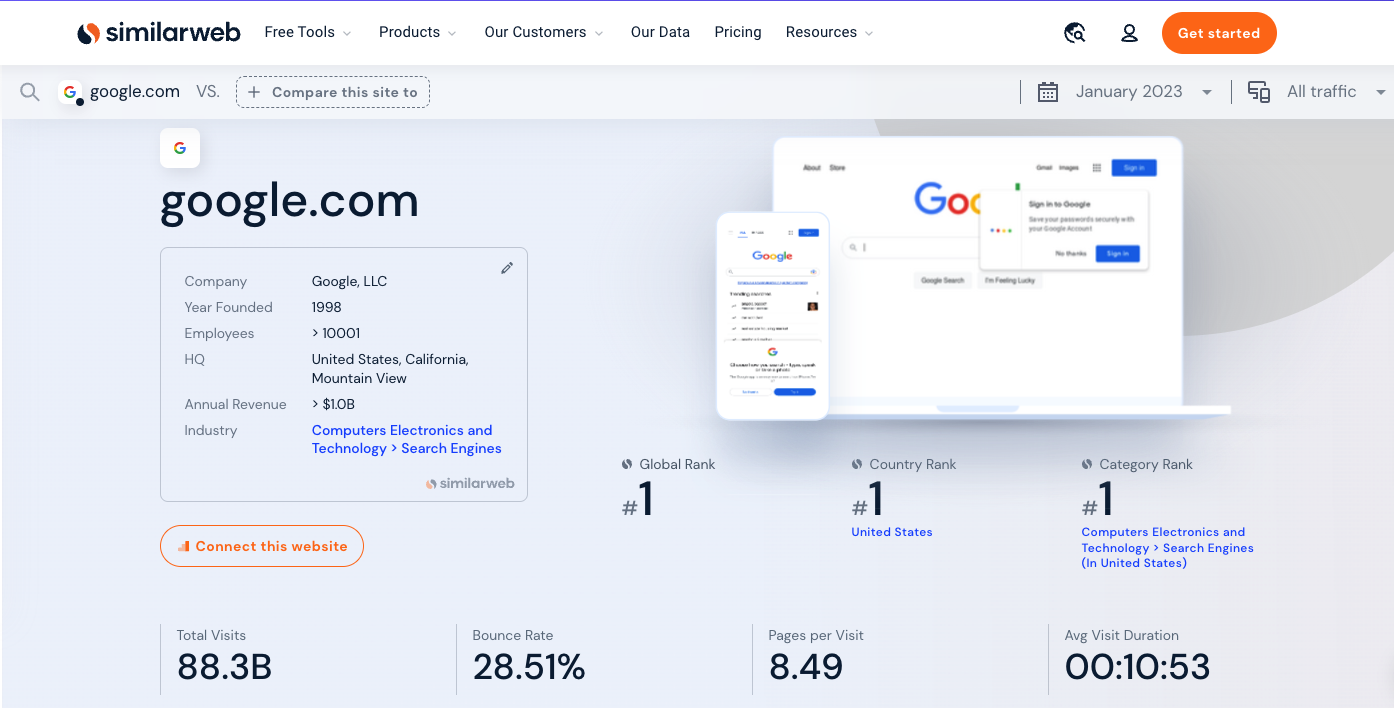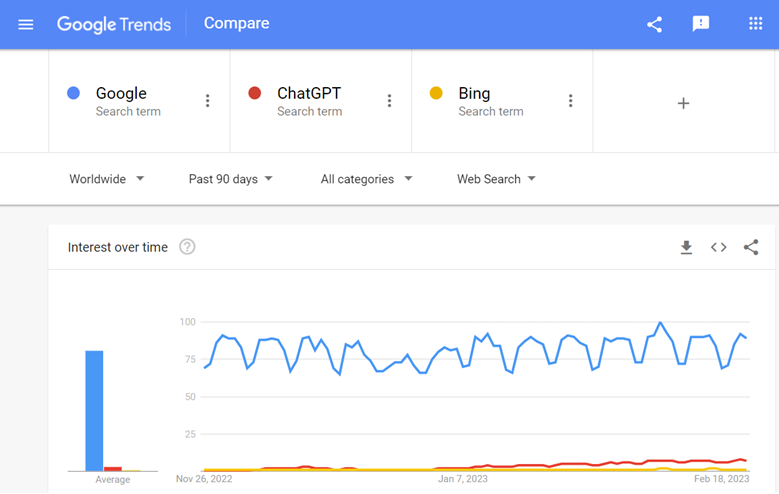I’ve written about search engine optimization (SEO) for over 20 years.
So, I wasn’t shocked when the editors asked me to refresh an article I wrote on October 21, 2020, titled “3 Strategic SEO Insights & Tactical Advice for 2021.”
But looking back at what I’d written two-and-a-half years ago, I realized that my actionable insights now need to be thoroughly updated in this era of constant change.
The advent of OpenAI’s ChatGPT on Nov. 30, 2022, has triggered a “code red” at Google, which rushed out a new experimental conversational AI service called Bard in response to Microsoft’s AI-enhanced Bing.
UBS estimates that ChatGPT reached 100 million monthly active users in January, 2 months after its launch. According to the Swiss bank’s analysts, it would be the fastest-growing online application in history.
So, what strategic SEO insights and tactical advice could I share with you today that will still be relevant a year from now?
What critical data or search trends would encourage you to display a motivational poster on your wall that advises everyone to “Keep Calm and Carry On”?
By the way, that last piece of advice is not half bad.
Google was launched on Sept. 4, 1998, and didn’t pass AltaVista to become the leading search engine until the second half of 2002 – about 4 years later.
And even the Panda Update, which shocked the SEO industry and effectively ended the “content farm” business model, only impacted 12% of queries, according to the History of Google Algorithm Updates.
The Penguin Update, which downranked websites that engaged in aggressive webspam, only impacted 3.1% of English queries.
And it’s worth recalling that the first iteration of the Panda Update started on Feb. 23, 2011, but was followed by 27 more adjustments until the final update on July 17, 2015. And the Penguin Update, which began on April 24, 2012, didn’t end until Sept. 23, 2016.
It may take more than four years to know the full impact of Google’s Bard AI or the new AI-powered Bing search engine.
So, SEO professionals would be well advised to “Keep Calm and Carry On.”
That means I can confidently share 10 strategic insights, bits of critical data, pieces of tactical advice, or search trends that will impact SEO in 2023 and beyond without losing too much sleep over the fact that 30% of them may not be relevant a year from now.
(After telling you why “the fundamental things apply as time goes by,” I’ll circle back to explain why a 70% success rate is the right benchmark.)
SEO remains an essential element of any digital marketing strategy.
And even though the search industry is constantly changing, Google is still the leading search engine.
According to Similarweb, Google.com got 3.2 billion unique visitors in January 2023, making it the most visited website globally. The search giant also got 88.3 billion visits in January 2023.
 Screenshot from Similarweb, February 2023
Screenshot from Similarweb, February 2023So, don’t bet the farm on Google going away anytime soon.
And if you need to keep other people within your company, or at one of your clients, from rushing off to panic stations, then show them the chart below from Google Trends, which displays worldwide web search interest over the past 90 days for the search terms Google, ChatGPT, and Bing.
You can calmly explain that the dips in interest for Google occur on weekends.
 Screenshot from Google Trends, February 2023
Screenshot from Google Trends, February 2023If Google remains the dominant search engine for the foreseeable future, then SEO pros don’t need to be retrained or replaced.
Why? Because they’re already familiar with Google Search Essentials (formerly Webmaster Guidelines).
And they’ve successfully navigated through the 22 Google Search ranking updates.
This is why I’m confident that more than 70% of SEO pros will continue successfully navigating the uncharted areas of keyword maps that bear the phrase: “Here be dragons.”
1. Focus On User Intent
One of the most important aspects of SEO is understanding user intent.
Google’s algorithms have become more sophisticated, and they’re now better able to understand the intent behind a query.
So, SEO pros should focus on creating content that satisfies user intent rather than just targeting specific keywords. This means creating content that is not only relevant to the user’s search query, but also provides helpful information or a satisfying experience.
Now, I realize this strategic insight isn’t breaking news.
But you still might benefit from re-reading my article, The Future of SEO Lies in the ‘Messy Middle’ of the Purchase Journey.
According to research by Google’s Market Insights team in the U.K., the “messy middle” is where people decide what to buy.
Among other things, this research found:
“People look for information about a category’s products and brands, and then weigh all the options. This equates to two different mental modes in the messy middle: exploration, an expansive activity, and evaluation, a reductive activity. Whatever a person is doing, across a huge array of online sources, such as search engines, social media, aggregators, and review websites, can be classified into one of these two mental modes.”
Let me translate this “big idea” into counter-intuitive tactical advice: SEO pros must create and optimize at least two pieces of content to address the user’s different intents in the “messy middle” of the purchase journey.
And, if your company or client is targeting half a dozen different segments, then you need to create and optimize at least a dozen pieces of content.
Creating and optimizing one page for each target segment is so 2019.
2. Create High-Quality Content
Content is still king, but if SEO managers want to become prime ministers (or presidents) someday, then they need to create more original, helpful content written by people, for people.
How can you ensure you’re creating high-quality content? By following Google’s long-standing advice and guidance for core updates to create content for people, not for search engines.
So, let me suggest you re-read my article, What Is A Content Marketing Matrix & Do We Need One?
It shows you how to use a content marketing planning tool to generate ideas for enchanting content that changes hearts, minds, and actions. That’s how you become the VP of SEO.
3. Prioritize E-E-A-T
On Dec. 15, 2022, Google updated its search rater guidelines – adding an extra E for Experience to the concept of E-A-T: Expertise, Authoritativeness, and Trustworthiness.
Although these guidelines don’t directly influence ranking, they are useful for anyone who works in SEO because they give us an idea of where Google wants its algorithms to go.
To improve your content’s E-E-A-T, someone with first-hand life experience on the topic should produce it.
If you can’t convince someone with experience to produce this content in-house, you need to find a freelance writer – or content creator – who has used your product or service, visited a place, or influenced brand purchases.
Unfortunately, many SEO pros still don’t think this is their job – even though the first mention of E-A-T occurred in 2014 when Google added the concept to its Search Quality Guidelines.
Even Google said:
“These are not fundamentally new ideas. And we’re by no means abandoning the fundamental principle that Search seeks to surface reliable information, especially on topics where information quality is critically important.”
If you’d like some practical advice, read How To Find Talented Writers To Fuel Top Quality Content Creation, which includes my interviews with a couple of thought leaders in this field.
4. Optimize YouTube Content
According to the Video & Visual Storytelling Survey by Content Marketing Institute (CMI) published on Oct. 27, 2022, 73% of marketers said videos have become more important to their business in the last year; 27% said they are about the same in importance; and, no one said videos have decreased in importance.
Why should SEO pros lose sleep over this critical data?
Because the content marketing department, not the SEO department, is jumping on this trend.
And that means many of the videos cranked out in 2023 and beyond won’t be optimized for search – let alone integrated into an overall SEO strategy.
So, here’s some tactical advice: first, read Sam Hollingsworth’s guide, YouTube SEO: How To Optimize Videos & Rank Higher.
Next, invite the content marketing department to a brown bag lunch to discuss ways to create great content together.
5. Earn High-Quality Links
Links continue to be one of Google’s most important ranking factors. And at least 70% of SEO pros have already read articles like:
Unfortunately, the lion’s share of chief communications officers (CCOs) and public relations officers (PROs) haven’t read articles like these.
So, only a handful of organizations use one of the most effective techniques to earn links to help your website rank higher on search engines.
Ironically, the biggest barrier is not journalists. Pogo once observed, “We have met the enemy and (they are) us.”
This means you might need to invite your CCO or PRO to a swanky restaurant to discuss link building instead of hosting another brown bag lunch.
But this is a better use of your time and money than trying to figure out a clever way around Google’s December 2022 link spam update, which can now detect both sites buying links and those used to pass outgoing links.
6. Optimize For Local Search
Brick-and-mortar businesses serving specific towns, cities, regions, and states know local search is important.
When done correctly, local SEO enables people to find information about their business, putting them one step closer to making the cash register ring.
And SEO pros specializing in local search know a consistent Name, Address, and Phone number (NAP), local links, local reviews, and star ratings, as well as optimized Google Business Profiles, are important parts of Google’s local search and Local Pack algorithms.
But, to learn the latest trends and tips to help your local business grow using local search optimization, local marketing, and local advertising, read Search Engine Journal’s A Guide to Local SEO, which tackles what you need to know about optimizing for local search.
7. Keep An Eye On Multisearch
In April 2022, Google introduced an entirely new way to search using text and images simultaneously.
With multisearch in Lens, users can go beyond the search box and ask questions about an object or refine their search by color, brand, or visual attribute.
To learn more about this, read Matt G. Southern’s article, Google Multisearch: A New Way To Search With Text & Images.
Then, read Roger Montti’s article, How Does Google Multisearch Affect SEO?
So, keep an eye on multisearch in 2023 and beyond.
8. Keep Your Ear To The Ground For Voice Search
According to Roger Montti’s article, Google: Voice Search Is Not The Future, Google’s Martin Splitt shared his opinion that voice search is not the future and that there will be no need to optimize for it.
Even though I’ve written about Amazon’s Big Game Commercial: Mind Reader twice in the past year, I haven’t paid much attention to voice search until I was prompted to read a couple of recent articles on this topic, including:
And while writing this article, I re-read Kristopher Jones’ How Can Voice Search Benefit Your SEO? He wrote:
- 40.2% of Americans use voice search.
- 71% of people prefer using voice search to physically typing out a search online.
- 27% of the online population worldwide uses voice search on mobile.
- 58% of people have used voice search to find information about local businesses.
In other words, four out of five people with a veritable ton of E-E-A-T think that voice search represents a phenomenal SEO opportunity.
So, keep your ear to the ground for new voice search developments in 2023 and beyond.
9. Migrate To Google Analytics 4 (GA4)
I’ll bet Google sent you an email with the subject line: “We’ll soon configure Google Analytics 4 for you.”
It said:
“For any customer who does not set up a GA4 property with basic settings, starting in March, we will configure one with a few basic settings consistent with the existing Universal Analytics property; this includes certain conversion events, Google Ads links, and existing website tags.”
This means the chaos expected on July 1, 2023, when standard Universal Analytics properties will stop working, has arrived ahead of schedule.
And, as Sun Tzu once observed, “In the midst of chaos, there is also opportunity.”
In my article, Google Analytics 4 Should Trigger Reorganizations & Agency Reviews, I said the advent of GA4 would cause the marketing department to start “freaking out” if the web analytics team – which still sits in the IT department in far too many organizations – doesn’t respond to urgent requests for “help” within a week, a day, or even an hour.
So, this is the perfect time for you to make the business case for moving the analytics team out of the IT department and into the SEO department.
If there’s any pushback, remind decision-makers that 53.3% of all website traffic comes from organic search, according to BrightEdge Research.
10. Build A War Room
If you’re a chief marketing officer (CMO) or vice president of Marketing and you move the analytics team into the SEO department, your team may ask to build a dashboard. Build a war room instead.
Why? Because “most dashboards tend to stink when it comes to helping the Executive make any decisions,” according to Avinash Kaushik, the Digital Marketing Evangelist for Google.
This is because the interpretation of the “easy-to-understand visuals” in most dashboards is left to the executive.
But most war rooms feature not only maps of the global market and charts of the company’s key performance indicators (KPIs), but also an analytics and insights manager with the experience, expertise, authoritativeness, and trustworthiness to interpret the trends and add context.
This “Analysis Ninja” can explain to executives why some key trends are up or down (in plain English).
And over time, executives will begin to ask their analytics and insights manager to recommend which actions or steps should be taken to move the dial.
And an Analysis Ninja can answer the question, “As a result of this trend (up or down) what was the impact on the company and its customers?”
Why Should SEO Pros Adopt The 70% Solution?
Now that I’ve shared 10 strategic SEO insights and some counter-intuitive tactical advice for 2023 and beyond, I’ll circle back to explain why a 70% success rate is the right benchmark.
Ty Kiisel’s article, 70% Solution: The Marine Corps Framework for Making Battlefield Decisions, should be required reading for every SEO manager who wants to become the VP of SEO someday.
The Marines teach their young officers what they call the 70% solution.
And it could be a good strategy to adopt for making decisions in situations where you don’t have all the information or resources you’d like.
In a perfect world, you’d have all the critical data you need to make informed decisions. But we don’t live in a perfect world.
Nevertheless, if you have 70% of the information you’d like to have, then you can still make good decisions – provided you accept the notion that you may need to adjust and compensate for the critical data you lack as you move forward.
And like battlefield commanders, most SEO managers never have all the resources they need to meet their objectives.
But it can sometimes be enough if you have good people and 70% of what you need. And finding creative solutions to challenges is a hallmark of successful SEO professionals.
Finally, are you 70% confident that your plan will succeed?
In other words, do you feel good about your plan’s success with the information and resources you have?
The Marines believe a well-conceived plan, along with taking the initiative, is more likely to succeed than doing nothing.
This is why I can confidently share 10 strategic insights, bits of critical data, pieces of tactical advice, or search trends that will impact SEO in 2023 and beyond without losing too much sleep over the fact that 30% of them may not be relevant a year from now.
The Marines have given us a framework for making decisions in less-than-ideal circumstances.
That is why you should “Keep Calm and Carry On.”
More Resources:
Featured Image: Monster Ztudio/Shutterstock
